
The Seattle Seahawks have had some terrific seasons as they enter their 50th year in the NFL. Most of the 90s are better forgotten, though. And no season was as bad as 1992.
12s have good reason to be a bit surly when it comes to the Seahawks' record over the past few years. We've been spoiled by the success of Pete Carroll's run. 10 playoff appearances in 14 seasons and a win in the Super Bowl isn't exactly chopped liver. And isn't chopped liver paté, anyway?
The last few years haven't been so great, but with only one losing season in the past 13 years, it's hard to complain.
Long-time 12s know what I mean. 7-10 definitely stung, but try to explain to younger fans just how awful it is to go through a 2-14 season. It's hard to believe that the Seahawks were ever that bad, right? They only won two games in their inaugural season, but even then, they scored almost 100 more points than their worst year and lost 12. So how on Earth did this happen?
1992 was the worst season in the history of the Seahawks
No season comes even close. That first year can be excused, as virtually every NFL team gets off to a rough start in its first year. Head coach Jack Patera improved their record to 5-9 in 1977 and made the Seahawks a winning team in just their third season. Just one year after Patera's departure, Chuck Knox came to town and took them to the playoffs in four of his first six seasons.
But as happens to the best coaches, the wheels started to come off. After five straight years with no better than nine wins to show for their efforts, Seattle replaced Knox with a coach with a better resumé. Even better than Knox, the new coach had two Super Bowl titles to his credit. To say that he underwhelmed in his first year in Seattle is the understatement of the... year? decade? 1992 was bad.
Tom Flores won the title game in 1980 and 1983 with the Raiders. By 1987, the bloom had faded a bit, as the Raiders fell to 5-10. I'll dive into his career in depth another time. For now, just remember that Flores was named the Seahawks' team president and general manager in 1989. When Seattle was unable to coax Dennis Erickson away from the University of Miami in 1992, Flores decided to take the reins himself.
This was just the first of a series of terrible decisions made by Flores as the GM. The Seahawks released quarterback Dave Krieg and turned to a stable of underperforming QBs. Krieg went 10-6 as the Chiefs' starting QB in 1992, while the Seahawks couldn't find anyone to line up behind center.
Casey Stengel could have been talking about Seattle when he asked, "Can't anybody here play this game?" For the record, his 1962 Mets had a winning percentage of .250. I can't imagine what he would have thought of a team that won at a .125 clip. Yes, it's about impossible to lose that often in baseball, but still...
So Krieg was gone. The team still had some excellent players. Hall of Famer Cortez Kennedy wasn't just a Pro Bowler. He was the league's Defensive Player of the Year. 14 sacks by an interior lineman will do that for you. Joe Nash and Jeff Bryant chipped in with 4.5 sacks each, while safety Eugene Robinson cleaned up on the back end, making the Pro Bowl himself.
The defense ranked 17th in points allowed and 10th in yards. Not great, but certainly not terrible.
Seattle's offense was atrocious
No, the problem was on offense. In a word, it stank. Imagine Pike Place if they forgot to bring in ice for three days, and you're beginning to get the picture. The running backs were excellent. Chris Warren is one of the Seahawks' top running backs of all time.
He had another all-time great in fullback John Williams blasting open holes for him. Between the two of them, the Seahawks ran for 1,356 yards on 337 carries. Warren averaged 4.6 yards per carry, and Williams added 556 yards on an astonishing 74 catches.
And there's the problem. When your fullback leads the team in receptions by 47 catches, you have issues. The entire wide receiver group only caught 90 passes on the season. Or what would be a mediocre season for Jaxon Smith-Njigba. You have to be a hard-core 12 to remember Tommy Kane, whose 27 catches were second to Williams'. Too bad they came on 70 targets.
The tight ends didn't exactly contribute to the aerial assault, either. They combined for 24 receptions, which would be an off-season for A.J. Barner. Seattle didn't have the best talent among their receiving corps; that's a fact. One thing that really hurt was that Brian Blades missed 10 games in '92, after hauling in 70 passes for over 1,000 yards in 1991.
But he only caught 19 passes in six games. He also saw his yards per game drop from 62.7 in '91 to 42.7 in 1992. Someone wasn't getting him the ball.
It all came down to the Seahawks quarterbacks
All of that points to the quarterbacks. And man, were they awful. Dave Krieg only threw 11 touchdowns versus 12 picks in 1991, but that was actually an improvement for him, as his ratio was worse in 1990. His completion percentage in 1991 was an excellent 65.6 percent. In the six games he missed, Jeff Kemp was a disaster, throwing 12 picks in just seven games. I can see why the Seahawks didn't fight his retirement.
But they had no one to replace Krieg. Kelly Stouffer and Dan McGwire were both on the '91 squad, and neither could displace Krieg or Kemp. I'll give Flores some credit; he understood that neither player was ready to start in the NFL. The only question here is, was Flores worse as a head coach or as a GM? His solution was to bring in Stan Gelbaugh.
That's a name that should bring shudders to long-term 12s everywhere. Remember, Flores drafted McGwire with the 16th overall pick, too.
Gelbaugh won his role in Seattle after a less-than-spectacular career on two other teams. He appeared in one game for the Bills in 1989, attempting no passes. He played for the London Monarchs in the short-lived World Football League, winning the championship game and the league's Offensive MVP. He crashed back to Earth with the Cardinals in 1991, losing all three of his starts while throwing three TDs against 10 picks.
Stouffer, McGwire, Gelbaugh - it made no difference
Yeah, that was Flores' backup plan. Stouffer got the call for the season opener and was sacked six times as the Seahawks only mustered 3 points against the Bengals. Cincinnati would only win four more games that year. The second contest came against Dave Krieg's Kansas City squad, which stifled Seattle 26-7. Stouffer was just sacked once, but fumbled once and was intercepted twice en route to a sparkling passer rating of 35.1.
Better days were ahead for Stouffer, as he managed not to lose to the Patriots in Week 3. He was still awful, fumbling twice and only throwing for 166 yards. But the defense held New England to 6 points, so Seattle came away with one of their two wins on the season. Cortez Kennedy's three sacks had a lot to do with that.
I won't bore you with the details of every awful game. Stouffer was predictably bad against the Dolphins. The Seahawks defense managed to make Dan Marino look bad, but Seattle still lost. Stouffer got the start again versus the Chargers in Week 6, but was replaced by Dan McGwire in the second quarter after a sack reinjured Stouffer's shoulder.
Not to be outdone, Seattle's former first-round pick promptly threw an interception on his first pass against the Chargers. The Seahawks lost that game and were shellacked by the Cowboys the following week. McGwire took a beating, too, as he was knocked out for the season. Enter Gelbaugh, who was 3 of 10 en route to a ridiculously awful passer rating of 1.2 in Seattle's fifth loss.
Gelbaugh played as well as anyone other than Flores would have expected, completing just 47 percent of his passes for six TDs and 11 picks. Stouffer managed to come back for the Week 11 game in mop-up duty in another brutal loss to the Raiders, then got two more starts.
He threw six interceptions and one touchdown while completing just 25 passes between the two. He was knocked out of the second contest and was essentially done for the season. Gelbaugh managed to lead the Seahawks to their second win in relief, an overtime victory over a mediocre Broncos squad.
Injuries played a role, but the 1991 offseason didn't help
Gelbaugh wrapped up the season with four straight losses. Much of the blame for the Seahawks' awful season was ascribed to injuries. At least 17 players spent time on injured reserve. Then again, the 2017 squad had 19 players on IR, and they still managed a winning season.
The injuries certainly didn't help, but the team made several offseason moves as well. Led by the departure of Krieg, Seattle also lost tight end Mike Tice and four offensive linemen after the 1991 season.
The failure to replace them falls on Tom Flores, the GM. The failure to get the most out of his team falls on Flores, the coach. Known as a keen offensive mind, it's hard to imagine how he thought any of his three quarterbacks on the 1992 roster were NFL starters. The trade for Stouffer was awful, and only exacerbated by adding Gelbaugh.
The Seahawks only scored 140 points for the entire season. That's the league record for a 16-game season. Their highest score was 17 points, which they managed just twice, both in losses. Rick Tuten punted 108 times, and at one point in the season, he had more punts than the team had points. We all love Michael Dickson, but no one wants to see him that often.
Consider this, 12s. Chris Warren had 134 receiving yards and added 252 in punt returns, with another 524 in kickoff return yardage. The Seahawks accounted for 4,542 all-purpose yards in '92, and Warren accounted for 42 percent of them. He doesn't get nearly enough credit when people talk about the great Seattle running backs. Just how terrible would the season have been without him?
The Seattle Seahawks would bounce back the next year with a 6-10 record. That's not exactly worthy of worldwide acclaim, but it's a darn sight better than the train wreck of 1992.

-1754043345-q80.webp)
